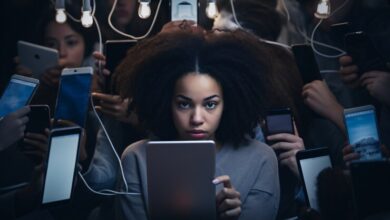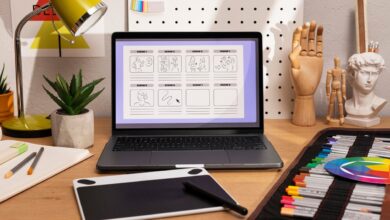AI-Generated Movie Posters: Revolutionizing the Film Industry’s Creative Landscape

In the age of artificial intelligence, AI-generated movie posters almost every industry is experiencing a wave of transformation. One area where AI has made significant inroads is in the world of graphic design and visual storytelling. AI-generated movie posters are rapidly gaining traction, redefining how filmmakers, marketing teams, and designers approach movie promotion. From indie projects to big-budget Hollywood films, AI tools are becoming essential in creating visually striking, cost-effective, and innovative designs.
In this article, we’ll dive deep into the realm of AI-generated movie posters, exploring their benefits, the technology behind them, and how they’re shaping the future of film promotion.
What Are AI-Generated Movie Posters?
AI-generated movie posters are visual designs created using artificial intelligence algorithms. These algorithms are capable of analyzing vast datasets of existing posters, learning patterns, and generating unique designs tailored to specific genres, themes, or artistic preferences.
The process typically involves tools like deep learning models, neural networks, and generative adversarial networks (GANs). These technologies enable AI to craft intricate and professional-grade visuals by blending creativity with data-driven insights.
Why AI-Generated Movie Posters Are Gaining Popularity
1. Speed and Efficiency
Traditional movie poster design involves weeks or even months of brainstorming, sketching, and revisions. AI tools, however, can generate multiple designs in a matter of hours. This speed enables filmmakers to test various concepts quickly and choose the most impactful one.
2. Cost-Effective Solutions
Hiring professional designers and artists can be expensive, particularly for indie filmmakers or small production houses. AI-generated posters significantly reduce costs while delivering high-quality results.
3. Enhanced Creativity
AI tools can analyze trends, colors, and layouts from thousands of movie posters, providing designs that are fresh and unconventional. These algorithms often combine elements in ways that human designers might not think of, resulting in truly unique visuals.
4. Data-Driven Customization
AI can tailor designs based on audience preferences. By analyzing viewer data, such as age, location, and favorite genres, AI can produce posters that resonate with specific target demographics.
How AI Creates Movie Posters: The Technology Behind It
The creation of AI-generated movie posters relies on advanced technologies, including:
1. Machine Learning (ML) Algorithms
Machine learning enables AI systems to study and replicate artistic styles. By analyzing thousands of existing posters, ML algorithms learn what works for specific genres and themes.
2. Generative Adversarial Networks (GANs)
GANs are a type of AI that pits two neural networks against each other: one generates the design, while the other evaluates its quality. This iterative process ensures that the final output is both innovative and polished.
3. Natural Language Processing (NLP)
Some AI tools incorporate NLP to understand the movie’s storyline, genre, and characters. This helps the AI create a poster that aligns with the film’s narrative.
4. Creative AI Tools
Popular platforms like DALL·E, MidJourney, and Stable Diffusion specialize in generating unique visuals. These tools allow filmmakers to input specific prompts, such as “a dark, mysterious sci-fi poster with futuristic elements,” and receive multiple design options.
Benefits for Different Stakeholders in the Film Industry
For Filmmakers
AI-generated posters offer an affordable way to market their films, especially for indie creators with limited budgets. They can focus more on storytelling and production while AI handles the promotional visuals.
For Marketers
AI tools provide data-driven insights, enabling marketers to create posters that appeal to their target audience. A well-designed poster can significantly boost ticket sales and audience engagement.
Challenges and Ethical Considerations
Despite the numerous advantages, AI-generated movie posters also come with challenges:
1. Authenticity Concerns
AI designs, while innovative, may lack the emotional depth and human touch that traditional artists bring to their work.
2. Copyright Issues
AI models are trained on existing data, which might include copyrighted images and designs. This raises questions about originality and intellectual property.
3. Job Displacement
However, most experts argue that AI will serve as a complementary tool rather than a replacement.
4. Overreliance on Trends
AI might overemphasize popular design trends, leading to a lack of originality. Filmmakers and designers must strike a balance between innovation and trend adherence.
Examples of AI-Generated Movie Posters in Action
Several filmmakers and studios have already embraced AI for their promotional campaigns:
- Indie Films: Independent creators often use AI tools to generate posters for festivals or online releases. These posters are eye-catching and cost-efficient.
- Short Films and Documentaries: AI tools help smaller productions stand out in a crowded market by producing high-quality visuals that rival big-budget films.
- Experimental Projects: Some filmmakers use AI-generated posters as part of their creative process, showcasing how technology can complement traditional artistry.
Future Trends in AI-Generated Movie Posters
As technology continues to evolve, AI-generated movie posters are poised to become even more sophisticated. Here are some trends to watch:
1. Interactive Posters
AI could create posters with AR (augmented reality) elements, allowing viewers to interact with the design using their smartphones.
2. Real-Time Customization
Imagine posters that adapt based on who is viewing them, offering personalized designs for each individual.
Conclusion
The rise of AI-generated movie posters marks a significant shift in the film industry’s approach to marketing and design. While challenges like authenticity and copyright issues need to be addressed, the benefits of speed, cost-efficiency, and enhanced creativity are undeniable.
As filmmakers and designers continue to explore the potential of AI, it’s clear that this technology will play a pivotal role in shaping the future of film promotion. Whether you’re a director, a graphic designer, or a movie enthusiast, AI-generated movie posters.




